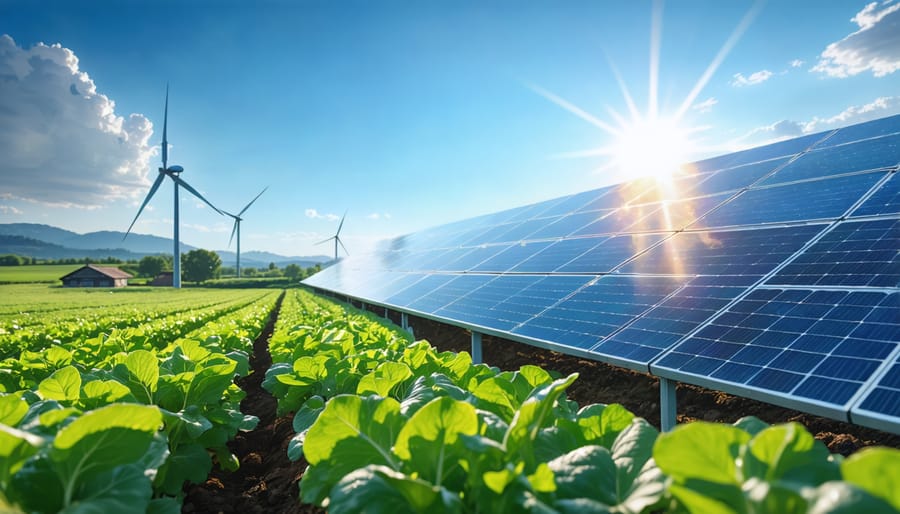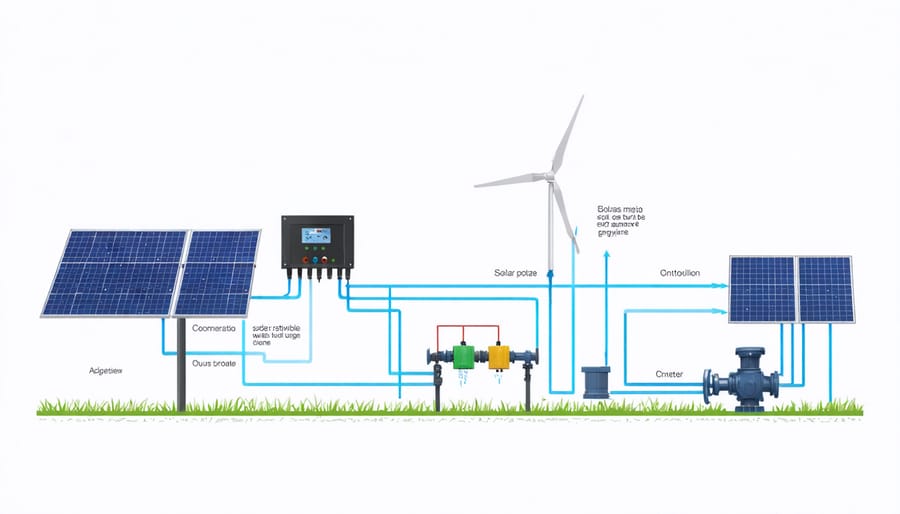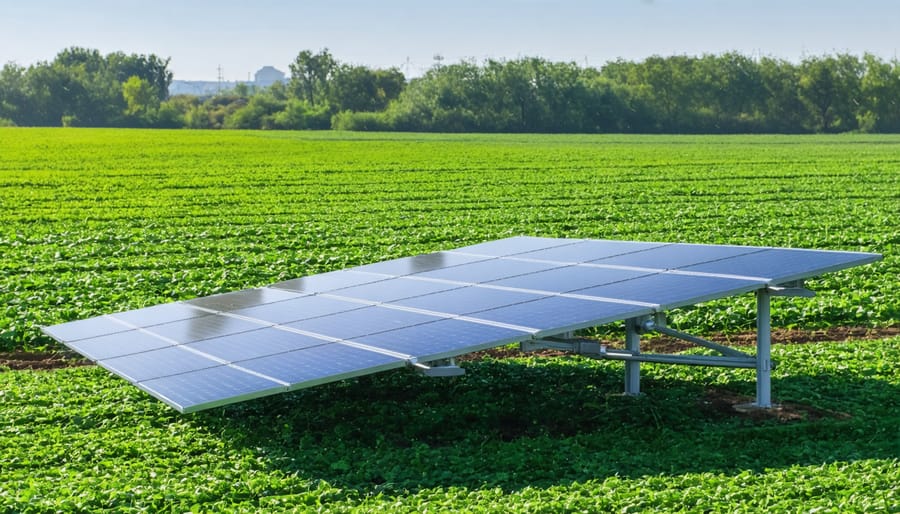Solar Water Pumping: The Future-Proof Solution for Off-Grid Agriculture

Harness the sun’s boundless energy to revolutionize water access through solar water pumping systems – a sustainable solution transforming European agriculture and water management. These innovative systems combine photovoltaic technology with advanced pumping mechanisms to deliver reliable water supply without dependence on traditional power grids or fossil fuels.
As Europe accelerates its transition to renewable energy, solar water pumping stands at the forefront of sustainable water management, offering up to 70% reduction in operating costs compared to conventional pumping methods. From small-scale garden irrigation to large agricultural operations, these systems provide scalable, environmentally conscious solutions that align perfectly with EU sustainability goals and climate action initiatives.
The technology’s remarkable versatility and efficiency make it particularly valuable across diverse European landscapes – from Mediterranean vineyards to Nordic greenhouses. With minimal maintenance requirements, zero fuel costs, and significant environmental benefits, solar water pumping systems represent a crucial investment in sustainable water infrastructure.
This comprehensive guide explores the essential components, implementation strategies, and practical considerations for deploying solar water pumping solutions, empowering you to make informed decisions about adopting this transformative technology for your specific needs.
How Solar Water Pumping Systems Work
Core Components
Solar water pumping systems rely on three essential components that work together seamlessly to deliver reliable water supply using clean energy. The heart of the system begins with high-quality solar panels, which convert sunlight into electrical power. These photovoltaic modules are specifically designed to maximise energy capture throughout the day, typically ranging from 250W to several kilowatts depending on the installation’s requirements.
The pump controller serves as the system’s brain, managing power flow and protecting the pump from damage. This sophisticated device optimises the system’s performance by adjusting to varying sunlight conditions and ensuring smooth operation. Modern controllers often include features like Maximum Power Point Tracking (MPPT) technology, which helps maintain optimal power output even during cloudy periods.
The water pump itself comes in two main varieties: submersible and surface pumps. Submersible pumps are installed directly in the water source and are ideal for deep wells, while surface pumps are mounted above ground and work best for shallow water sources like ponds or streams. These pumps are specially designed to operate on DC power from solar panels or can include AC variants with inverters.
The integration of these components creates a robust and efficient system that can deliver water reliably without depending on the grid, making it particularly valuable for remote European locations and agricultural applications.

System Integration
The effectiveness of a solar water pumping system lies in how its components work together harmoniously. The solar panels convert sunlight into electrical energy, which flows through the charge controller to protect the system from voltage fluctuations. This controlled power then drives the pump motor, while the pump controller optimises performance based on available sunlight and water demand.
Integration often includes smart monitoring systems that provide real-time data on water flow, energy production, and system health. Modern installations feature automatic switching between solar power and grid backup, ensuring continuous operation even during cloudy periods. The water storage component acts as a buffer, storing excess water during peak solar hours for use during low-light periods.
For maximum efficiency, system sizing and component matching are crucial. The pump’s specifications must align with the solar array’s output capacity, while storage tanks should match daily water requirements. Professional integrators use advanced software tools to simulate system performance under various conditions, ensuring optimal component selection and configuration for each specific installation.
Benefits for European Agriculture

Cost Savings and ROI
Solar water pumping systems offer remarkable financial benefits through significant reductions in operational costs and energy expenses. The initial investment, while substantial, typically yields returns within 3-5 years through eliminated electricity bills and reduced maintenance requirements. For instance, a medium-sized agricultural operation in Southern Europe can save approximately €2,000-3,000 annually on energy costs alone.
These systems prove particularly valuable as benefits for remote agricultural communities, where grid electricity access is either unreliable or expensive. The elimination of fuel costs for diesel pumps can result in savings of up to 70% over traditional pumping methods.
When considering ROI, solar pumping systems demonstrate impressive long-term value. A well-maintained system can operate efficiently for 20-25 years, with panel efficiency remaining above 80% even after two decades. The only significant maintenance costs involve occasional cleaning and potential pump servicing every 5-7 years.
European Union incentives and agricultural subsidies further enhance the financial appeal, with many regions offering grants covering 30-50% of installation costs. Modern systems also feature smart controllers that optimize water usage, leading to additional savings through reduced water consumption and improved irrigation efficiency. These combined benefits make solar water pumping an increasingly attractive investment for both small-scale farmers and large agricultural enterprises.
Environmental Impact
Solar water pumping systems stand at the forefront of environmental sustainability, offering significant reductions in carbon emissions compared to conventional pumping methods. By harnessing solar energy instead of fossil fuels or grid electricity, these systems can reduce CO2 emissions by up to 2.5 tonnes per year for a typical agricultural installation.
The environmental benefits extend beyond carbon reduction. These systems contribute to sustainable water management by operating most efficiently during peak sunlight hours, which naturally aligns with periods of highest water demand for irrigation. This synchronisation helps prevent water waste and promotes more efficient resource utilisation.
In European contexts, solar water pumps play a crucial role in water conservation efforts. Modern systems incorporate smart controllers that optimise water extraction based on actual needs, preventing aquifer depletion and maintaining groundwater levels. This technology is particularly valuable in regions facing water scarcity or during drought conditions.
Furthermore, solar pumping systems eliminate the risk of soil and water contamination associated with fuel-powered pumps. There’s no possibility of fuel leakage or oil spills, protecting local ecosystems and maintaining water quality. The systems also operate silently, minimising noise pollution and protecting local wildlife habitats.
For European farms and businesses transitioning to sustainable practices, solar water pumping represents a concrete step toward meeting environmental targets while maintaining operational efficiency. The systems’ long lifespan and minimal maintenance requirements further reduce their environmental impact through reduced manufacturing and replacement needs.
Design and Implementation
Site Assessment
A successful solar water pumping installation begins with a thorough site assessment. The first crucial factor is solar resource evaluation, which involves analysing the location’s average daily sunlight hours and seasonal variations. This assessment should consider potential shading from nearby structures or vegetation that might affect solar panel performance.
Water source characteristics play a vital role, including the depth of the water table, water quality, and seasonal fluctuations. For wells, the static and dynamic water levels must be measured accurately. The distance between the water source and the point of use affects system design and efficiency.
The daily and seasonal water demand patterns need careful consideration, particularly for agricultural applications. This includes peak usage times and variation throughout the year. The terrain between the water source and storage or distribution points influences pipe routing and pump selection.
Local climate conditions, such as temperature extremes and wind exposure, impact system performance and durability. Additionally, site accessibility for installation and maintenance, available space for solar arrays, and local building regulations must be evaluated to ensure a successful implementation.
Sizing and Configuration
Proper sizing and configuration of a solar water pumping system is crucial for optimal performance and efficiency. The process begins with a thorough assessment of your daily water requirements, considering factors such as peak demand periods and seasonal variations. This evaluation aligns closely with principles of off-grid solar system design to ensure reliable operation.
Key configuration parameters include the total dynamic head (the vertical distance water needs to be pumped), flow rate requirements, and available solar resources at your location. For European installations, it’s essential to account for varying daylight hours across seasons and local weather patterns. The solar array should be sized to provide sufficient power during the lowest solar radiation months.
A properly sized system typically includes a 20-30% capacity buffer to accommodate unexpected demands and system inefficiencies. The pump selection must match both the required flow rate and pressure requirements while operating within the voltage range of your solar array. Professional assessment tools and simulation software can help optimize these calculations for your specific application.
Installation Best Practices
Proper installation of solar water pumping systems requires careful planning and adherence to established solar panel installation guidelines to ensure optimal performance. Begin by conducting a thorough site assessment, considering factors such as solar exposure, water source location, and pumping requirements. Position solar panels at the ideal angle (typically 30-45 degrees in Europe) and orient them southward to maximize sun exposure throughout the day.
Install the pump controller in a weather-protected enclosure near the power source, ensuring easy access for maintenance while protecting it from environmental elements. When laying cables, use UV-resistant materials and proper conduit protection to prevent degradation. The water pump should be mounted securely, with appropriate shock absorption to minimize vibration.
Implement proper grounding systems and surge protection devices to safeguard against electrical irregularities. Install monitoring equipment at accessible points to facilitate regular system checks. Finally, ensure all connections are waterproof and that the system includes shut-off valves and pressure relief mechanisms for safe operation and maintenance.
Maintenance and Support
Routine Maintenance
Regular maintenance is crucial for ensuring the longevity and optimal performance of your solar water pumping system. A well-maintained system can operate efficiently for 15-20 years with proper care. Begin with weekly visual inspections of solar panels, checking for dust, debris, or bird droppings that may reduce efficiency. Clean the panels using soft brushes and appropriate cleaning solutions, especially during dry seasons.
Monthly maintenance should include checking all electrical connections, ensuring proper system grounding, and inspecting pump functionality. Pay special attention to wiring insulation, which can deteriorate over time due to weather exposure. Monitor the pump’s performance metrics through your control system to detect any efficiency drops early.
Quarterly tasks should focus on more thorough inspections of mechanical components, including checking mounting structures for stability and corrosion. Lubricate moving parts as recommended by the manufacturer, and test backup systems if installed. During winter months in colder European regions, ensure freeze protection measures are working correctly.
Annually, schedule a professional inspection to assess overall system health, calibrate sensors, and perform any necessary repairs. Keep detailed maintenance logs to track system performance and identify patterns that might indicate developing issues. This proactive approach helps prevent unexpected breakdowns and extends the system’s service life while maintaining optimal efficiency.

Troubleshooting
When operating a solar water pumping system, you may encounter several common issues that can affect performance. Understanding these challenges and their solutions helps ensure reliable operation.
One frequent issue is reduced pump performance, often caused by air in the system. To resolve this, check all pipe connections for leaks and ensure proper system bleeding during startup. If performance remains low, inspect the solar panels for dust or debris accumulation, which can significantly impact energy generation. Regular cleaning maintains optimal efficiency.
Battery-based systems might experience storage-related problems. Monitor battery voltage regularly and check for corroded terminals or connections. If batteries aren’t holding charge properly, they may need replacement or professional servicing.
Controller malfunctions can disrupt system operation. Look for error codes on the display and verify all electrical connections are secure. If the controller shows no signs of power, check the fuse and incoming power connections from the solar array.
Unusual noises or vibrations often indicate pump problems. This could mean debris in the pump, worn bearings, or improper installation. Stop the system immediately if you notice these symptoms and inspect the pump assembly for blockages or damage.
For issues beyond basic troubleshooting, consult a qualified technician. Keep detailed maintenance records and perform regular system checks to prevent major problems from developing.
Solar water pumping systems represent a pivotal shift towards sustainable water management across Europe. As energy costs continue to rise and environmental concerns take center stage, these systems offer a compelling solution that combines economic efficiency with ecological responsibility. The technology has proven its worth across various applications, from agricultural irrigation to industrial processes and residential water supply.
The future outlook for solar water pumping is exceptionally promising. Technological advancements are steadily improving system efficiency while reducing implementation costs, making this solution increasingly accessible to a broader range of users. European initiatives supporting renewable energy adoption, coupled with growing water scarcity concerns, are driving increased investment in solar pumping infrastructure.
For businesses and homeowners alike, the value proposition is clear: reduced operational costs, energy independence, and environmental stewardship. The initial investment is offset by minimal maintenance requirements, zero fuel costs, and impressive system longevity. Moreover, as battery storage technology continues to evolve, the reliability and effectiveness of these systems will only improve.
Looking ahead, we can expect to see more innovative applications, enhanced system integration capabilities, and improved smart monitoring solutions. The transition to solar water pumping systems represents not just a technological upgrade, but a strategic investment in a sustainable future for European water management.
Leave a Reply